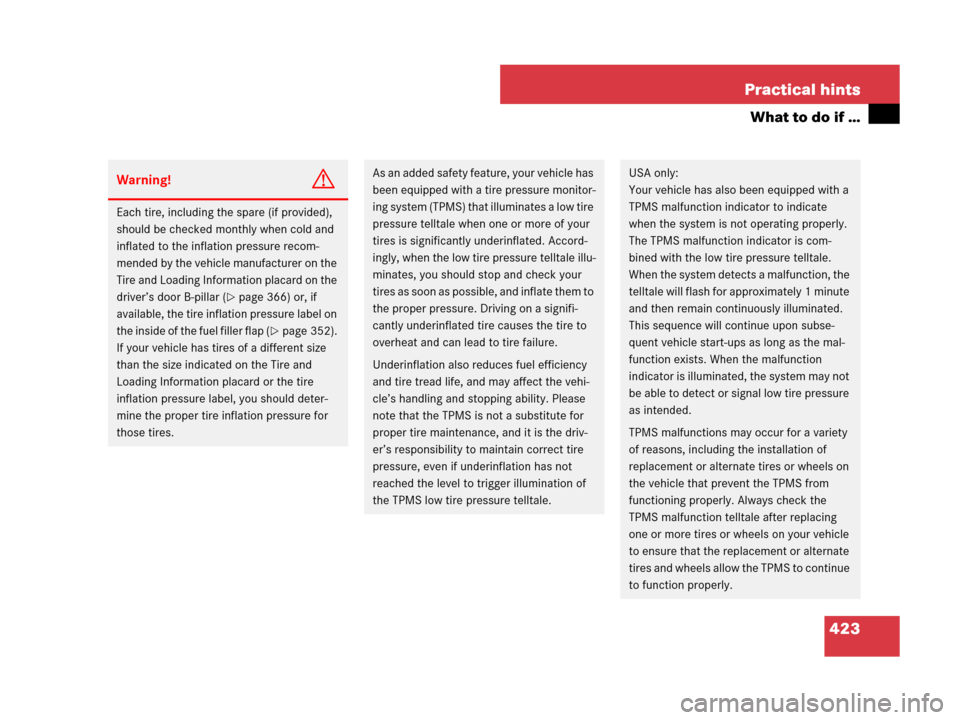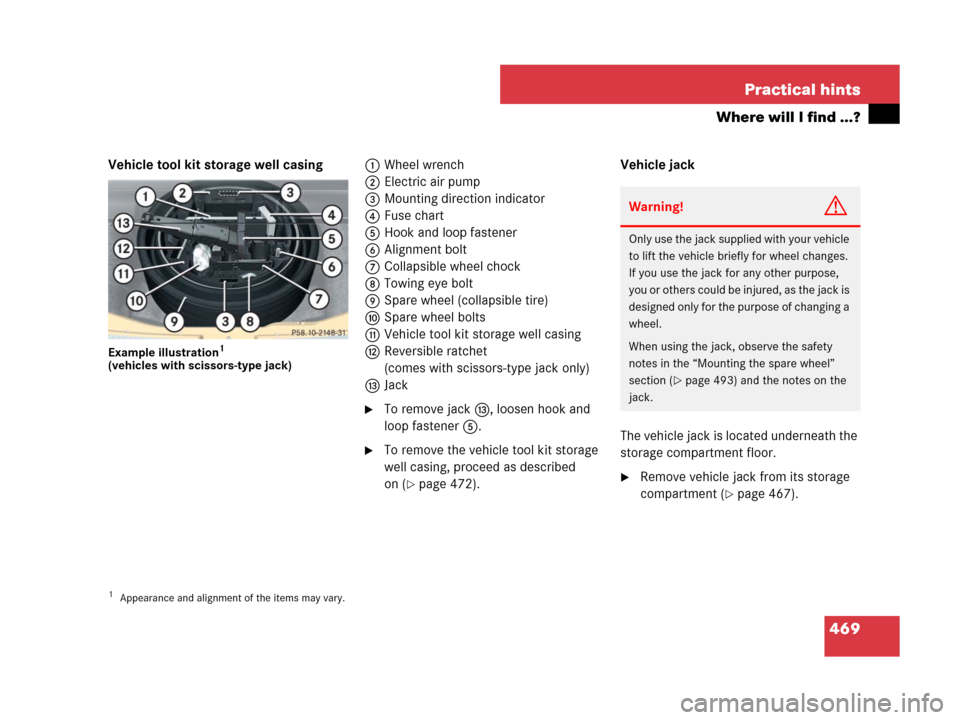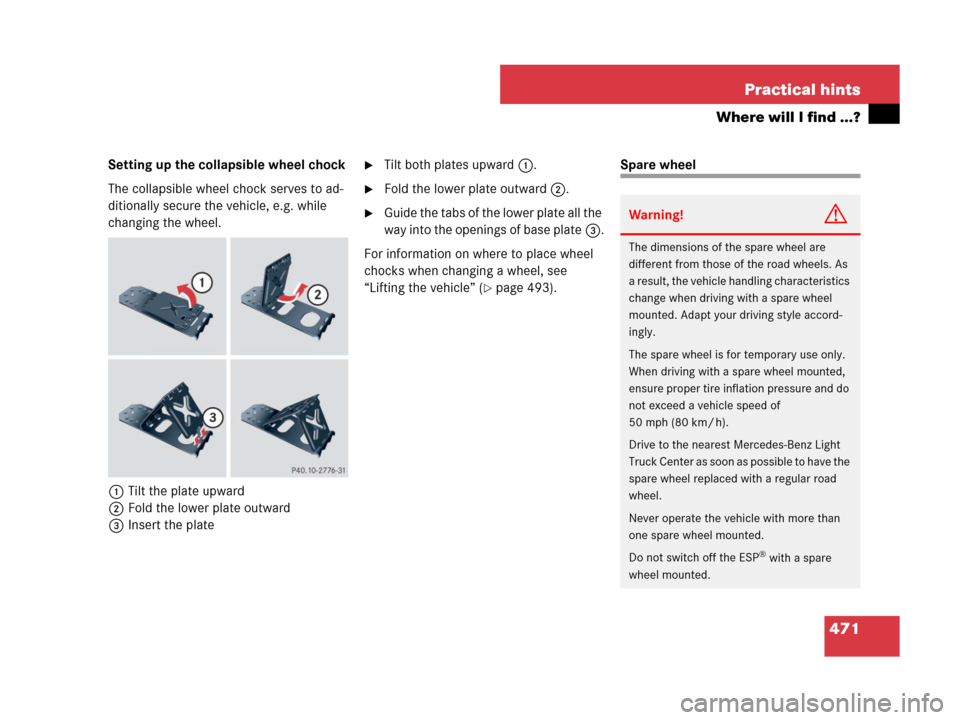Page 424 of 569

423 Practical hints
What to do if …
Warning!G
Each tire, including the spare (if provided),
should be checked monthly when cold and
inflated to the inflation pressure recom-
mended by the vehicle manufacturer on the
Tire and Loading Information placard on the
driver’s door B-pillar (
�page 366) or, if
available, the tire inflation pressure label on
the inside of the fuel filler flap (
�page 352).
If your vehicle has tires of a different size
than the size indicated on the Tire and
Loading Information placard or the tire
inflation pressure label, you should deter-
mine the proper tire inflation pressure for
those tires.
As an added safety feature, your vehicle has
been equipped with a tire pressure monitor-
ing system (TPMS) that illuminates a low tire
pressure telltale when one or more of your
tires is significantly underinflated. Accord-
ingly, when the low tire pressure telltale illu-
minates, you should stop and check your
tires as soon as possible, and inflate them to
the proper pressure. Driving on a signifi-
cantly underinflated tire causes the tire to
overheat and can lead to tire failure.
Underinflation also reduces fuel efficiency
and tire tread life, and may affect the vehi-
cle’s handling and stopping ability. Please
note that the TPMS is not a substitute for
proper tire maintenance, and it is the driv-
er’s responsibility to maintain correct tire
pressure, even if underinflation has not
reached the level to trigger illumination of
the TPMS low tire pressure telltale.USA only:
Your vehicle has also been equipped with a
TPMS malfunction indicator to indicate
when the system is not operating properly.
The TPMS malfunction indicator is com-
bined with the low tire pressure telltale.
When the system detects a malfunction, the
telltale will flash for approximately 1 minute
and then remain continuously illuminated.
This sequence will continue upon subse-
quent vehicle start-ups as long as the mal-
function exists. When the malfunction
indicator is illuminated, the system may not
be able to detect or signal low tire pressure
as intended.
TPMS malfunctions may occur for a variety
of reasons, including the installation of
replacement or alternate tires or wheels on
the vehicle that prevent the TPMS from
functioning properly. Always check the
TPMS malfunction telltale after replacing
one or more tires or wheels on your vehicle
to ensure that the replacement or alternate
tires and wheels allow the TPMS to continue
to function properly.
Page 444 of 569

443 Practical hints
What to do if …
Display messagePossible cause/consequencePossible solution
Tire Pressure Monitor
InoperativeThe TPMS or Advanced TPMS* is
malfunctioning.�Have the TPMS or Advanced TPMS* checked by an
authorized Mercedes-Benz Light Truck Center.
Tire Pressure Monitor
Inoperative
No Wheel SensorsThere are wheels without appropriate wheel
sensors mounted (e.g. winter tires).�Have the TPMS or Advanced TPMS* checked by an
authorized Mercedes-Benz Light Truck Center.
�Have the wheel sensors installed by an authorized
Mercedes-Benz Light Truck Center.
Tire Pressure Monitor
Wheel Sensor MissingVehicles with Advanced TPMS*:
One or more sensors are defect (e.g.
battery is empty).
The respective tire is indicated by
---
instead of the tire inflation pressure in the
multifunction display.
�Have the Advanced TPMS* checked by an autho-
rized Mercedes-Benz Light Truck Center.
Vehicles with Advanced TPMS*:
One or more wheels without appropriate
wheel sensors mounted (e.g. spare tire).
The respective tire is indicated by
---
instead of the tire inflation pressure in the
multifunction display.
�Have the wheel sensors installed by an authorized
Mercedes-Benz Light Truck Center.
Tire Pressure Monitor
Currently UnavailableThe TPMS or Advanced TPMS* is unable to
monitor the tire pressure due to a nearby
radio interference source.�As soon as the causes of the malfunction have been
removed, the TPMS or Advanced TPMS* automati-
cally becomes active again after a few minutes
driving.
Page 468 of 569
467 Practical hints
Where will I find ...?
�Where will I find ...?
First aid kit
The first aid kit is stored under the cargo
compartment floor, see “Vehicle tool kit”
(
�page 467).
Vehicle tool kit
The vehicle tool kit is stored under the
cargo compartment floor.
The vehicle tool kit includes:
�Towing eye bolt
�Wheel wrench
�Alignment bolt
�Vehicle jack
�Fuse chart
�Collapsible wheel chock
�Wheel bolts for spare wheel
(if applicable, see “Mounting the spare
wheel” (
�page 498))1Cargo compartment floor, lowered
2Handle cover
�Open the tailgate (�page 119).
�Push in handle cover2 as indicated
by arrow and pull handle.
�Lift cargo compartment floor 1.
iCheck expiration dates and contents for
completeness at least once a year and replace
missing / expired items.
��
Page 470 of 569

469 Practical hints
Where will I find ...?
Vehicle tool kit storage well casing
Example illustration1
(vehicles with scissors-type jack)
1Wheel wrench
2Electric air pump
3Mounting direction indicator
4Fuse chart
5Hook and loop fastener
6Alignment bolt
7Collapsible wheel chock
8Towing eye bolt
9Spare wheel (collapsible tire)
aSpare wheel bolts
bVehicle tool kit storage well casing
cReversible ratchet
(comes with scissors-type jack only)
dJack
�To remove jackd, loosen hook and
loop fastener 5.
�To remove the vehicle tool kit storage
well casing, proceed as described
on (
�page 472).Vehicle jack
The vehicle jack is located underneath the
storage compartment floor.�Remove vehicle jack from its storage
compartment (
�page 467).
1Appearance and alignment of the items may vary.
Warning!G
Only use the jack supplied with your vehicle
to lift the vehicle briefly for wheel changes.
If you use the jack for any other purpose,
you or others could be inju re d, as the j ac k is
designed only for the purpose of changing a
wheel.
When using the jack, observe the safety
notes in the “Mounting the spare wheel”
section (
�page 493) and the notes on the
jack.
Page 472 of 569

471 Practical hints
Where will I find ...?
Setting up the collapsible wheel chock
The collapsible wheel chock serves to ad-
ditionally secure the vehicle, e.g. while
changing the wheel.
1Tilt the plate upward
2Fold the lower plate outward
3Insert the plate�Tilt both plates upward1.
�Fold the lower plate outward2.
�Guide the tabs of the lower plate all the
way into the openings of base plate3.
For information on where to place wheel
chocks when changing a wheel, see
“Lifting the vehicle” (
�page 493).
Spare wheel
Warning!G
The dimensions of the spare wheel are
different from those of the road wheels. As
a result, the vehicle handling characteristics
change when driving with a spare wheel
mounted. Adapt your driving style accord-
ingly.
The spare wheel is for temporary use only.
When driving with a spare wheel mounted,
ensure proper tire inflation pressure and do
not exceed a vehicle speed of
50 mph (80 km/ h).
Drive to the nearest Mercedes-Benz Light
Truck Center as soon as possible to have the
spare wheel replaced with a regular road
wheel.
Never operate the vehicle with more than
one spare wheel mounted.
Do not switch off the ESP
® with a spare
wheel mounted.
Page 473 of 569

472 Practical hints
Where will I find ...?
Your vehicle is equipped with a spare
wheel with collapsible tire. The spare
wheel is located underneath the cargo
compartment floor (
�page 467).
Removing the spare wheel
1Retaining screw
2Spare wheel
3Vehicle tool kit storage well casing
�Remove the jack from the vehicle tool
kit (
�page 469).
�Loosen retaining screw 1 by turning it
counterclockwise.
�Turn vehicle tool kit storing well
casing3 by approximately 180°.
The electric air pump (
�page 469)
points towards the rear.
�Remove vehicle tool kit storage well
casing 3.
�Remove spare wheel 2.
Reinstalling the spare wheel after use
There are two guide pins in the spare wheel
well that serve to hold the spare wheel in
place.1Guide pins
1Guide pins
2Spare wheel
iFor information on how to mount the spare
wheel, see “Mounting the spare wheel”
(
�page 493).
iIf retaining screw 1 does not come loose,
turn vehicle tool kit storing well casing 3 slightly
counterclockwise. Retaining screw 1 should
then come loose easily.
Page 474 of 569
473 Practical hints
Where will I find ...?
�Place spare wheel 2 into spare wheel
well.
Make sure spare wheel 2 is placed
precisely on guide pins 1.
�Insert vehicle tool kit storage well
casing 3 (
�page 472) into spare
wheel 2.
The electric air pump (
�page 469)
must point to the rear.
�Turn vehicle tool kit storing well
casing3 (
�page 472) by approxi-
mately 180°.
The electric air pump (
�page 469)
points in direction of travel.
�Fasten retaining screw 1
(
�page 472) by turning it clockwise.
�Insert the jack into the vehicle tool kit
storage well casing (
�page 469).
�Close and pull tight the hook and
loop fastener that secures the
jack (
�page 469).
iThe vehicle tool kit storage well casing
should now be positioned according to mounting
direction indicators 3 (
�page 469).
Page 493 of 569

492 Practical hints
Flat tire
Preparing the vehicle
�Vehicles with AIRMATIC*:
Make sure the vehicle level is set to
highway level (
�page 276).
�Park the vehicle in a safe distance from
moving traffic on a hard, flat surface
when possible.
�Turn on the hazard warning flasher
(
�page 150).
�Turn the steering wheel so that the
front wheels are in a straight-ahead
position.
�Set the parking brake (�page 65).
�Set the automatic transmission to
position P (
�page 190).
�Turn off the engine (�page 66).
�Have any passenger exit the vehicle at
a safe distance from the roadway.
�Remove the SmartKey from the starter
switch.
Vehicles with KEYLESS-GO*:
�Turn off the engine by pressing the
KEYLESS-GO* button once
(
�page 66).
�Open the driver’s door (this puts
the starter switch in position 0,
same as with the SmartKey re-
moved from the starter switch). The
driver’s door then can be closed
again.
�Remove the KEYLESS-GO*
start/stop button from the starter
switch.
Warning!G
The dimensions of the spare wheel are
different from those of the road wheels. As
a result, the vehicle handling characteristics
change when driving with a spare wheel
mounted. Adapt your driving style accord-
ingly.
The spare wheel is for temporary use only.
When driving with spare wheel mounted,
ensure proper tire inflation pressure and do
not exceed a vehicle speed of
50 mph (80 km/ h).
Drive to the nearest Mercedes-Benz Light
Truck Center as soon as possible to have the
spare wheel replaced with a regular road
wheel.
Never operate the vehicle with more than
one spare wheel mounted.
Do not switch off the ESP
® with a spare
wheel mounted.
iOpen doors only when conditions are safe to
do so.